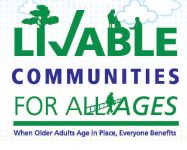Partners has extended the conversation on Aging in Place to include a wide variety of fields and topics and has created a set of values for planning for the aging population that extends beyond the traditional issues of healthcare, retirement communities, and social security. These include:
Housing/Shelter
A livable community for all ages provides a range of accessible housing types at various levels of affordability. Most communities, however, face major economic and political challenges to providing a diverse array of housing stock, including apartments, homesharing options and compact housing.
Civic Engagement
The gifts and talents of every individual should be put to use so communities can become better places for all. Retired individuals have opportunities to use the skills and experience they’ve developed over time to serve their communities directly and take leadership roles. Engaged older adults report being more satisfied with retirement than less active adults.
Productive aging promotes the ability of older persons to engage in economic and social activities whether they are paid or not. A study found that 5.4 million retired individuals are ready and able to return to work—one out of three would like to volunteer.
Vulnerable Elderly
Aging in Place is a particular challenge for individuals living in economically ravaged neighborhoods, those with language barriers or educational deficiencies, single women, and others with challenges that fall outside the standard model of service delivery.
Culture/Life Long Learning/Recreation/Enrichment
Lifelong learning and participation in cultural and recreational activities are important for older adults’ health and communities’ quality of life and economic competitiveness.
Transportation
To Age in Place successfully, people need to have safe and easy access to services, amenities and support networks (such as friends and family). These basic components of daily life should be accessible to people of all ages and abilities, including children and youth, people with disabilities and older adults.
Health/Wellness/Social Services
A livable community for all ages has a high capacity both to address and to prevent health problems. A good wellness environment encourages physical activity, promotes preventive health programs such as health fairs and free screenings, and offers opportunities to engage older adults in the civic and cultural life of the community.
Placemaking/Community Redesign
The physical characteristics of a livable community for all ages can be seen on any “Main Street,” where some residences are close to stores and services and people can easily travel by car, on foot, or by bicycle, or where they can access convenient public transit.
Technology
Technology has much to offer older adults in areas such as telemedicine, off-site monitoring, and social engagement. A technologically prepared community will be a more competitive community for attracting all ages.
Institutional Responses—Libraries, Hospitals, Universities and more
Are the libraries, cultural centers, hospitals, and similar institutions in the community developing programs and offerings that are catering to all ages? Providing these opportunities can build a powerful advocacy voice in the community in support of these institutions.
Aging in the Suburbs
Older Americans have one overwhelming factor in common with Americans in general: most are living in the suburbs where mobility is essential and public transportation is sparse, social services and health care are not uniform, and housing options are limited.
Aging in Place with a Comprehensive Approach
The surest way to develop a livable community for all ages is to take the comprehensive approach. Apply a filter that ranges across all age groups to the full spectrum of public agencies to see if they provide options for older people.

